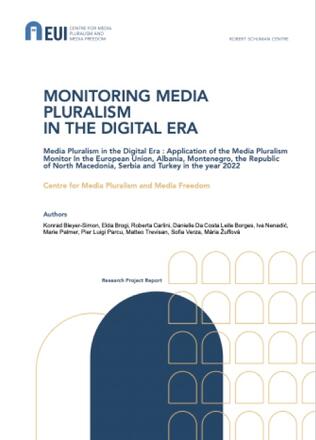
The Media Pluralism Monitor 2023 report assesses the risks to media pluralism in 32 countries, including 27 EU member states and 5 candidate countries, based on data from the year 2022. The report focuses on three main areas of the media landscape: Fundamental Protection, Market Plurality, Political Independence, and Social Inclusiveness.
The overall risk score of the Fundamental Protection area decreased slightly to 34% (from 35% of 2021), remaining in the medium-risk range. 20 out of 32 countries were assessed as low-risk, 11 as medium-risk, and just Turkey as high-risk. The Protection of freedom of expression, of the right to information and of Journalists’ standards indicators remained at a medium-risk level, showing little improvements. A minimal deterioration from 24% to 25% of risk affected the Independence and effectiveness of the media authority indicator. A consistent reduction of risk involved the Universal reach of traditional media and access to the Internet indicator.
The risk in the Market Plurality area increased, reaching an average of 69%, indicating a high-risk level. No country was assessed as low-risk, just 11 as medium-risk and the rest high-risk. The main reason concerns the concentration of media ownership and dominance of a few platforms in the digital market. In particular, in regard to indicators such as Plurality of media providers, Plurality in digital markets, Media viability and, Editorial independence from commercial and owner influence, very few or even no countries reach a low-risk level.
Solely, the Transparency of media ownership indicator improved, but the risk remains significant in digital media.
The Political Independence area shows a medium risk level, of around 48%. Independence of public service, Political independence of the media and Editorial autonomy remain the higher risk indicators, but still in the medium-risk range. The indicator of Audiovisual media, online platforms and elections and the one of State regulation of resources and support to the media sector show a medium-risk level, but are in proximity of the low-level range.
The risk level in the Social Inclusiveness area remained stable at 54% compared to 2021, indicating a medium risk level. Gender equality and Media literacy indicators reflect a negative tendency, with higher risk than in 2021. The other indicators (Local, regional, and community media, Representation of minorities in the media and, Protection against disinformation and hate speech) are under a positive trend with decreasing risk.
The report highlights a number of recommendation for all the 4 areas:
- Regarding the Fundamental Protection area, some of the more relevant suggestions are:
- decriminalisation of defamation
- implementation of the EU Directive on whistleblowers
- to bridge the difference between de jure and de facto access to public information
- implementation of anti-SLAPP legal frameworks and effective protection of journalists
- Regarding Market Plurality area, some of the more relevant suggestions are:
- more transparent list of media ownership
- accurate monitoring of merger’s impact on editorial autonomy and integrity
- introduction of self-regulatory bodies in the media to disclose any conflict of interest for the owner of the media outlet
- Regarding Political Independence area, some of the more relevant suggestions are:
- national legislations against conflicts of interest
- measures to avoid political-motivated appointments and dismissals of editors
- Transparent allocation of funding to the media by the State
- Regarding Social Inclusiveness area, some of the more relevant suggestions are:
- appointment procedure revisal to ensure a better representation of minorities
- introduction of comprehensive gender equality policies
- media literacy learning for both teachers and for students
- police training to contrast hate speech
The content of this article can be used according to the terms of Creative Commons: Attribution-NonCommercial 4.0 International (CC BY-NC 4.0) . To do so use the the wording "this article was originally published on the Resource Centre on Media Freedom in Europe" including a direct active link to the original article page.

